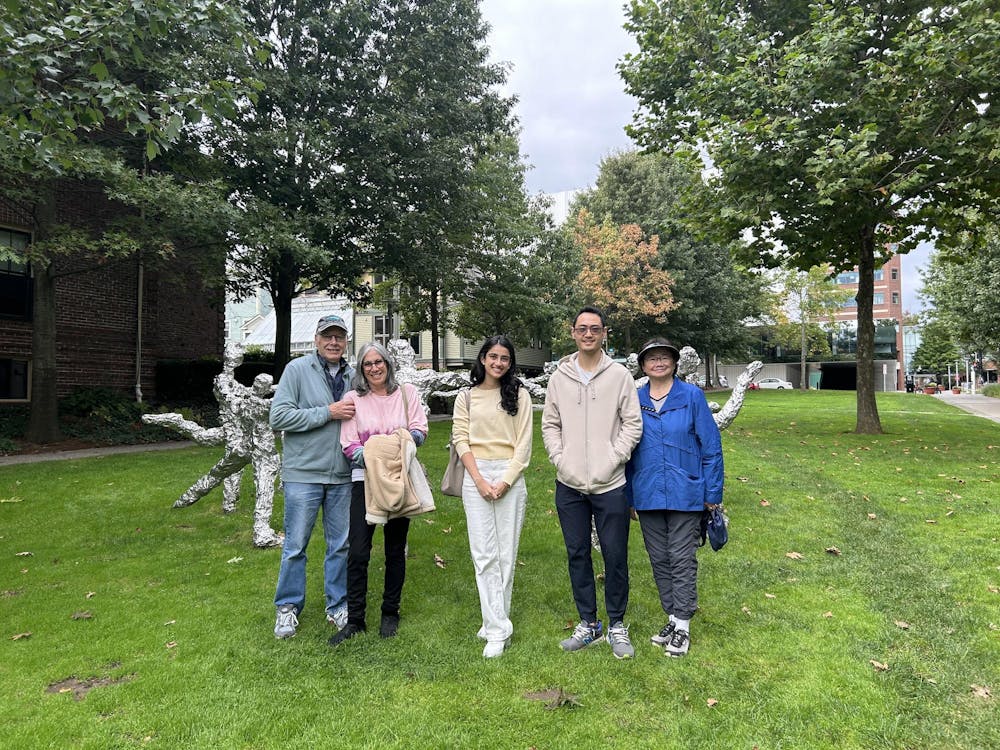Last spring, the Brown Arts Institute launched a new initiative: student-led Public Art Tours. Offered every weekend until Nov. 17, the tours are each curated by student guides and provide historical background on some of Brown’s 30 most prominent pieces of public art.
The idea for the Public Art Tours came to Nicole Wholean, the University curator and registrar of the BAI galleries, after she was selected to Brown’s Public Art Working Group during the COVID-19 pandemic. The working group aims to “enrich the cultural, intellectual and scholarly life” of both the University and Providence community through public art.
“It seemed like we could benefit from some outdoor arts programming,” Wholean said. “I thought public art would be a great vehicle for safe, socially-distanced outdoor arts programs.”
Depending on the day of the week, each tour either begins at Eli Harvey’s “Bronze Bruno” on the Main Green or Tom Friedman’s “Circle Dance” on the Campus Walk near Waterman Street. Student tour guides take their audience to between six and eight different artworks on campus, providing background information about each piece’s creation, design and origin.
Last fall, while researching for the creation of the Public Art Tours, Wholean visited Princeton University to observe its counterpart, the “Campus Collections” tour, which inspired her to make the process as hassle-free as possible for both tour guides and viewers.
Princeton’s tour was the most casual of those that Wholean attended. “You don’t have to pre-register,” she said. “You basically just show up and it happens.” Likewise, BAI’s Public Art Tours do not require pre-registration or payment from participants.
Wholean also cited Brown’s ArtsCrew Program and its human resources specialist, Jamil Jorge, as major players in bringing the Public Art Tours to fruition. Jorge “is doing all of the hiring paperwork and (scheduling),” she said.
Wholean emphasized the importance of diversity in selecting the initial 16 tour guides. “I was really interested in getting people from different backgrounds. I wanted people who are in different concentrations,” she said. “I thought they would add a new perspective to the program.”
As an art history concentrator, Kiara Bose Roy ’25 said she was interested in becoming a tour guide in order to become more involved with the arts at Brown.
“I thought it was a very exciting opportunity to learn more about Brown’s collection and make it more accessible to Brown students as well as the wider Providence community,” Bose Roy said.
The tour guide training involves a mandatory six-part workshop series, according to Wholean. Over the course of the workshop, prospective tour guides learn the basics of hosting a tour as well as general knowledge of Brown’s public art collection.
Each guide curates their own selection of artworks to display on their tour. “I try to choose a mix of different types of artwork, whether they’re contemporary works, or memorials, or really old ancient Roman recreations,” Bose Roy said.
Bose Roy cited the accessibility of Public Art Tours as a highlight of working in the program.
“As a tour guide, I've loved helping people see art as something they can connect with, regardless of their background or prior knowledge,” she said. “Public art is meant to be accessible and is meant to engage the community it’s placed within.”
Likewise, Wholean said the tours’ low barriers to entry are a major factor in upholding the mission of BAI. “A lot of art’s (purpose) is about preservation and access,” she said. “I love that we are a free program that wants to share Brown’s history and culture with the greater public.”





